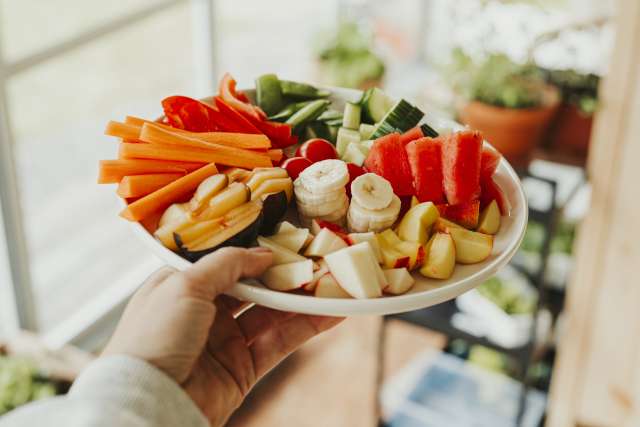Imagine eating only foods that are completely unprocessed and uncooked. People who follow the raw food diet do this every day.
The raw food diet has a few variations. Some plans require your food to stay below 104 degrees Fahrenheit, while others allow up to 118 degrees. Some include only vegan (plant-based) foods, and others include eggs, dairy and even meat — if it’s raw. Regardless of the exact rules you choose, the goal is to eat foods in their natural state.
This diet might sound simple and healthy, but it carries risks. Fortunately, there’s a way you can reap the benefits of the raw diet while avoiding the drawbacks.
Benefits of the raw food diet
A crisp apple, some fresh spinach and a ripe avocado — all of these raw foods are healthy choices. And this is where the raw food diet shines. Benefits of “going raw” include:
1. Better gut health
Raw produce is generally high in fiber, which feeds your gut microbiome — the community of helpful bacteria and yeasts that live in your gut. A healthy microbiome helps prevent digestive issues such as diarrhea or constipation. It may also boost your immune system and help you fight off conditions including heart disease and Type 2 diabetes.
2. High nutrient intake
Fruits, vegetables, nuts and seeds — the bulk of the raw diet — are high in vitamins, minerals and antioxidants. These types of foods may help prevent diseases such as Type 2 diabetes, some types of cancer and obesity.
3. No ultra-processed foods
Many Americans eat diets that include too many ultra-processed foods, such as soft drinks, chips, baked goods and fried foods. If you eat a raw food diet, these types of foods are off-limits. Research suggests that ultra-processed foods are linked to more than 30 different health problems, including heart disease, Type 2 diabetes and some cancers.
4. Sustainability
The raw food diet can be beneficial to the environment because it offers:
- Less waste: Raw foods often have minimal packaging, so you’re putting less garbage in landfills. You can also compost unused parts of your food, such as peach pits and avocado peels.
- Lower greenhouse gases: Plant-based foods use less energy, land and water than animal-based foods.
- Smaller carbon footprint: Locally grown fruits and vegetables don’t require long shipping times.
5. Weight loss
On a raw food diet, most of your foods are naturally low in calories. Plus, high-fiber foods such as fresh produce and nuts take longer to digest, which could help you stave off hunger.
Risks of the raw food diet
There are some risks to going completely raw with your diet, including:
1. Food-related illness
Eating a raw diet that includes animal foods can be dangerous. Raw dairy, eggs and meat may contain harmful bacteria such as E. coli, listeria and salmonella that can cause serious illness.
Even raw fruits and vegetables can be contaminated with germs, so washing raw produce thoroughly is essential.
2. Nutrient deficiencies
A vegan raw food diet may not contain all the nutrients you need. It can be challenging to get enough vitamin B12, iron, calcium and omega-3 fats, which are mainly found in meat, eggs and dairy. Children, pregnant people and those with health conditions should not follow the raw food diet without a health care provider’s approval.
3. Practical challenges
It can be difficult to stick to a raw food diet. Family gatherings and restaurants may not have raw options. It’s also difficult to travel because raw foods often need to be kept clean and refrigerated.
A “mostly raw” diet can be safe and healthy
A strict raw food diet isn’t a good fit for most people, but a modified version can be a great option. Try going “mostly raw” by eating:
- Cooked legumes and whole grains: Black beans, lentils, whole wheat and other legumes and grains contain protein, vitamins and fiber, but they’re not safe to eat raw. Cook them thoroughly or buy pre-cooked varieties before enjoying.
- Plenty of produce: Focus on eating a variety of colorful fruits, vegetables, nuts and seeds to get important nutrients in your diet. You can eat most of these foods raw or cooked, but avoid adding salt or sugar.
- Small amounts of animal products: Enjoy occasional servings of cooked eggs, fish, poultry and meat. If you consume dairy, choose pasteurized products, which have removed any dangerous bacteria.
- Whole foods over ultra-processed foods: Try replacing crackers or chips with celery and carrots. Instead of cookies for dessert, reach for fresh fruit. These substitutions add up over time and may help you achieve your healthy eating goals.
Beware of strict, extreme diets
Embracing some parts of the raw food diet can be a great choice, but eating all raw, all the time is risky. Before you start any new diet, talk to your health care provider. They can help you create a plan that fits your medical needs and personal taste.



